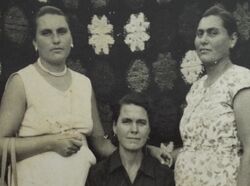Biology:Family resemblance (anthropology)
Family resemblance refers to physical similarities shared between close relatives, especially between parents and children and between siblings.[1] In psychology, the similarities of personality are also observed.
Genetics
Heritability, defined as a measure of family resemblance, causes traits to be genetically passed from parents to offspring (heredity), allowing evolutionarily advantageous traits to persist through generations.[2][3][4][5] Despite sharing parents, siblings do not inherit identical genes, making studies on identical twins (who have identical DNA) especially effective at analyzing the role genetics play in phenotypic similarity.[6] Studies have found that generational resemblance of many phenotypic traits results from the inheritance of multiples genes that collectively influence a trait (additive genetic variance).[7] There is evidence of heritability in personality traits. For example, one study found that approximately half of personality differences in high-school aged fraternal and identical twins were due to genetic variation - and another study suggests that no one personality trait is more heritable than another.[6][8]
Environment
Family resemblance is also shaped by environmental factors, temperature, light, nutrition, exposure to drugs, the time that different family members spend in shared and non-shared environments, are examples of factors found to influence phenotype.[9][10][11] Phenotypes found to be largely environmentally determined in humans include personality, height, and weight.[12][10][13][14] Twin studies have shown that more than half of the variation in a few major aspects of personality are environmentally determined, and that environmental factors even affect traits like immune response and how children handle stress.[10][15][16] Additionally, anomalous findings, such as second-degree relatives of alcoholics, showing surprising similarities to them have led some researchers’ attempts in generating better models that account for the environmental impacts on influences like cultural inheritance, family structure and head of household, which have been shown to influence family resemblance.[17]
See also
- Biological Anthropology
- Twins
- Look alike
- Heredity
References
- ↑ Who Do You Look Like? DNA and Family Resemblance Across Generations
- ↑ "Resemblance and investment in children" (in fr). International Journal of Psychology 48 (3): 285–90. June 2013. doi:10.1080/00207594.2011.645482. PMID 22385106.
- ↑ "Familial resemblances in human whole blood transcriptome". BMC Genomics 19 (1): 300. April 2018. doi:10.1186/s12864-018-4698-6. PMID 29703154.
- ↑ "Estimating Heritability from Nuclear Family and Pedigree Data". Statistical Human Genetics. Methods in Molecular Biology. 850. 2012. pp. 171–86. doi:10.1007/978-1-61779-555-8_10. ISBN 978-1-61779-554-1.
- ↑ Brodie, Edmond (2014). The Princeton Guide to Evolution. Princeton University Press. pp. 221–229.
- ↑ 6.0 6.1 "Why are children in the same family so different from one another?". International Journal of Epidemiology 40 (3): 563–82. June 2011. doi:10.1093/ije/dyq148. PMID 21807642.
- ↑ "Meta-analysis of the heritability of human traits based on fifty years of twin studies" (in En). Nature Genetics 47 (7): 702–9. July 2015. doi:10.1038/ng.3285. PMID 25985137. https://espace.library.uq.edu.au/view/UQ:364460/UQ364460_OA.pdf.
- ↑ Ahern, Frank M.; Johnson, Ronald C.; Wilson, James R.; McClearn, Gerald E.; Vandenberg, Steven G. (May 1982). "Family resemblances in personality" (in en). Behavior Genetics 12 (3): 261–280. doi:10.1007/bf01067847. ISSN 0001-8244. PMID 6889860.
- ↑ "Environmental Influences on Gene Expression | Learn Science at Scitable" (in en). https://www.nature.com/scitable/topicpage/environmental-influences-on-gene-expression-536.
- ↑ 10.0 10.1 10.2 "Why are children in the same family so different from one another?". International Journal of Epidemiology 40 (3): 563–82. June 2011. doi:10.1093/ije/dyq148. PMID 21807642.
- ↑ Sulikowski, Danielle (2016-08-08). Evolutionary Theory: Fringe or Central to Psychological Science. Frontiers Media SA. ISBN 9782889199204. https://books.google.com/books?id=WhUvDwAAQBAJ&pg=PA53.
- ↑ Eysenck, H. J. (March 1990). "Genetic and Environmental Contributions to Individual Differences: The Three Major Dimensions of Personality". Journal of Personality 58 (1): 245–261. doi:10.1111/j.1467-6494.1990.tb00915.x. PMID 23750379.
- ↑ "Why are we getting taller as a species?" (in en). Scientific American. https://www.scientificamerican.com/article/why-are-we-getting-taller/.
- ↑ Roser, Max; Appel, Cameron; Ritchie, Hannah (8 October 2013). "Human Height". Our World in Data. https://ourworldindata.org/human-height. Retrieved 2018-08-09.
- ↑ "Effect of genome and environment on metabolic and inflammatory profiles". PLOS ONE 10 (4): e0120898. April 2015. doi:10.1371/journal.pone.0120898. PMID 25853885. Bibcode: 2015PLoSO..1020898S.
- ↑ "Environmental influences on family similarity in afternoon cortisol levels: twin and parent-offspring designs". Psychoneuroendocrinology 31 (9): 1131–7. October 2006. doi:10.1016/j.psyneuen.2006.07.005. PMID 16997489.
- ↑ "Multifactorial inheritance with cultural transmission and assortative mating. III. Family structure and the analysis of separation experiments". American Journal of Human Genetics 31 (3): 366–88. May 1979. PMID 572636.
Bibliography
- "Analysis of family resemblance. II. A linear model for familial correlation". American Journal of Human Genetics 26 (3): 331–59. May 1974. PMID 4857114.
- "The Effect of Consanguinity on the Distribution of Continuously Variable-Characteristics". American Journal of Human Genetics 13 (1 Pt 1): 28–31. March 1961. PMID 17948464.
 |


